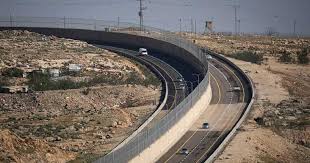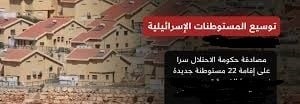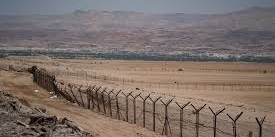By: Madeeha Al-A’raj
The National Bureau for defending land and resisting settlements ( nbprs ) stated in its latest weekly report , that within their plan for building new racist roads, and preparing the ground for annexing wide areas of the West Bank lands, the Israeli Authorities under the Century Deal, especially, the Israeli Ministry of Finance approved last week a tender for the construction of a bypass road near the Hawara town, south of Nablus city, that cost NIS 250,000,000, after 2 and a half years of postponement, where the settlements chiefs sit-in a hunger strike for long time in front of the ministry demanding the approval of the plan. According to Yossi Dghan, president of the so-called ‘Samaria settlement Council’, Israel is taking great steps in changing the face of settlement, and the bypass road will turn the mountainous settlements in this area to a point of attraction for tens of thousands of settlers.
By the end of 2017, PM Netanyahu has approved a budget of NIS 800,000,000 for West Bank bypass roads, which included a road to the Za’tra Junction and the 5.7 km long inter-Samaria road near the towns and villages of Ourta, Odla. Al-Hawara and Betta, south of Nablus city, where it links Nablus settlements with the 60th bypass road to Jerusalem, the 6.5 km long Al-Arroub bypass road, which runs from Gush Etzion Junction south of Bethlehem to the settlement of Karmi Tsour On the lands of Beit Umar and Halhoul towns, the Kiryat Arba settlement bloc and the settlements of Hebron are linked together within a Shriani line connected mainly with settlers and within the bypass of the 60th bypass road. The 5.3-km western bypass road to link settlements west of Ramallah through the Beit Erih settlement with the road network behind the Green Line and the Nabi Elias bypass road, the Karni Shamron settlement bloc . The East Highway Known as the American Sign, which extends from the area near Har Homa settlement ‘Abu Ghneim’ southeast of Jerusalem to a bridge passing through the area of Sur Baher and then to Al-Zaeem area 8 km, which is crossed by a 1.6-km tunnel. This street, or part of it, is also known as the ‘American Street’. The Gush Etzion road toward the Dead Sea, which runs from the Nekodim settlement bloc, Kfar Eldad, to the Dead Sea with the aim of laying a geographical barrier ‘a path separating Bethlehem and Hebron Governorates’. The 475-km railway project to link the Ariel settlement bloc with the railway network behind the Green Line, as well as the tunnels, which the occupation authorities plan to link beyond the Green Line as a Qalandia Tunnel .
The case is the same with settlement outposts as they are on the agenda of the occupation authorities. In a provocative step, members of the various right-wing parties at the Knesset participated in a tour organized by the so-called ‘Lobby of the Land of Israel’ for the Gush Etzion settlement bloc and the surrounding areas, in preparation for discussing the requests for preserving areas C. it was noted that, Mark Tsill, representative of the US Republican Party in Israel, participated in the visit as a guest of honor. Likud Knesset member Haim Katz criticized the government’s behavior toward settlements and outposts, calling for construction in settlements instead of leaving them. On her part, Ilit Shakif, a right-wing leader, said it is important to keep agriculture in settlements, she also considered the visit as important, especially as there are members from Likud and Al-Haridem in it. The Knesset member for the right bloc, Tesileel Smoterch said that this tour is important to support 20.000 settlers living in there, he expressed his hope that the current period is suitable under Trump’s presence to construct more settlements and outposts.
At the same time, the hilltop youth continue their provocative practices, as settlers from Kokhaf Yacoub settlement established a new settlement near Kafr Malek village east of Ramallah city, setting up houses in Al-Najma area east of the village, constantly set up houses and demolished them in the same place. However, they reconstructed them, and tried under the protection of the occupation forces to control water springs in the village of Ein Samia for the purpose of confiscating the water and depriving the residents of it. Settlers also set up a tent on the top of Mount Nejma, located in the village of Jalod, southeast of Nablus, surrounded by olive fields from all sides, some of which are more than 70 years old, and are threatened with settlement again. It is worth mentioning that Al-Najma Mountain is located in a security area that is not accessible for Palestinians without special permits from the occupation authorities, and settlers started to establish a settlement outpost on the top of Jabal Sabih in the town of Beta, south of Nablus city, where they set some tents to establish a settlement outpost. Knowing that the Beta town in early March witnessed clashes to reject settlement on its lands . The recent settlers’ attacks came within the framework of the settlement project in Itamar settlement and seeking to create a new one.
In a new step that includes the approaches of annexation and piracy, the Minister of Communications at the occupation government decided to grant the Israeli Communications co ‘Bezak’ a license for the full work inside the West Bank settlements, after it worked for 36 years without a license. According to Hebrew sources, Bezak will be allowed to organize infrastructure extensively, provide customer service and technical support, develop the Internet to become high-speed, and improve quality standards as in the rest of the cities within the Green Line. ‘Israel is in the process of reducing the huge gaps in the advanced infrastructure of the settlement population, and there is no difference between Ofra and Yucinam ‘in Haifa’, where everyone has the right to a sophisticated infrastructure,” said Yoaz Handel.
On the level of the silent policy of ethnic cleansing practiced by the Government, the Euro-Mediterranean Human Rights Observatory prepared a human rights memo to European officials on Israel’s policy of demolishing and destroying the infrastructure, especially those financed by the European Union in the occupied Palestinian territories. The memo clarified that Israel destroyed or seized during 2019 about 127 buildings financed by international donors ‘mainly from the European Union and its member states’ in occupied Jerusalem and the regions areas C. The observatory showed that these numbers are twice as high as they were in 2018. Israel issued the latest demolition orders for EU-funded projects, two weeks ago, against the Ras al-Teen School near the Mukhamir village, east of Ramallah, angering European officials, calling on Israel to stop the demolition, which has major implications for the humanitarian aspects. The observatory also documented ‘Israel’s destruction during 2019’ where about 104 Palestinian buildings in East Jerusalem only, the memo clarified that Israel ‘escalated the operations of demolishing of the Palestinian buildings during the Corona apandemic, and observed the destruction of about 89 houses in the occupied Jerusalem since the beginning of 2020 until last August, compared to the destruction of 104 houses in 2019, and 72 in 2018.
List of Israeli Assaults over the Last Week Documented by the National Bureau:
Jerusalem:
- Handing demolition notices of 13 inhabited houses in the Silwan town south of the Al-Aqsa Mosque, including 10 houses in the AL-Bustan area of Silwan, and 3 others in the Karam al-Sheikh under the pretext of not having a building permit. Knowing that there are unlicensed houses for settlers only a few meters away.
- Removing a residential tent belonging to Khalil Abu Dahuk, expelled him with his livestock in the Beit Aksa village, northwest of Jerusalem.
- Changing the name of the historic Damascus Gate square in the east of Jerusalem through placing signs which replace its name to Hadar and Hadas square, referring to two female soldiers of border guards killed in the area.
Hebron:
- Attacking the participants in an anti-settlement activity in the Tha’la and Um Zeitonah areas in Yatta, south of Hebron, assaulted and abused them. It should be noted that the activity rejected the settlement policy and the annexation of land in favor of the settlement expansion, and as a response to the Israeli plan of seizing 3600 dunums in these areas.
- Demolishing a 70-meter residential house, a 200-meter barn and a livestock feed tent belonging to Akram Sari Abu Sabha, in the Al-Fakhid area of the Mosafer Yatta.
- Demolishing the water systems for the communities along the area extending from the Khilat Al-Dabea to the Al-Mafkra area of the Mosafer Yatta.
- Bulldozing the citizens’ lands in Khirbet Zanote, near the Al-Thaheriya town, west Hebron, and south of the West Bank.
Bethlehem:
- Demolishing an agricultural room belonging to Raed Khalil Goda and a tent to his brothe.
- Seizing a water tank and pipes in the Swanah area southwest of Al-Khader town, under the pretext on not having a building permit.
- Demolishing Samih Ahmad Salah’s house and seized its equipment in the Khirbat Alia area south of Al-Khader, closed it and prevented citizens from entering and getting out of it.
- Confiscating an agricultural tractor for a farmer from the Nahalin town, west of Bethlehem, during working in his land, transported it through a military truck to the military headquarters in the Gush Etzion settlement complex, under the pretext of violating a military order.
- Demolishing a 120m2 house belonging to Samih Ahmad Salah.
- Notifying to stop working in a house under construction in the Taqoa town belonging to Suleiman Sabah, under the pretext of not having a building permit.
Ramallah:
- Handing notices to dozens of citizens in the Qalandia village, northwest of Jerusalem, to stop work in 3 houses, dozens of facilities and retaining walls, under the pretext of building without a permit.
Nablus:
- Pumping wastewater into the agricultural lands of the al-Laban al-Sharqiya village, south of Nablus, planted with olive trees.
- Severe damages to the electricity network in the Jalod village, southeast of Nablus, which led to the collapse of the 1 km electricity line, the fall of the cables and the damage of 25 electricity poles.
- Pumping wastewater into the citizens’ lands in the Deir Al-Hatab village, east Nablus, coincided with the olives harvest season, causing a big loss for farmers.
- Expelling farmers from their lands in the Deir al-Hatab town and attacked them in the Khilat al-Jagob area.
- Cutting about 30 olive trees in the Qaryot town, south of Nablus, belonging to Bilal Mahmoud Raja.
- Pumping wastewater into the Qariot town, causing the damage to a large numbers of olive trees.
Jordan valley:
- Fencing an area of 30,000 donums east of khilat Makhol in the northern valleys, extending from the Maskiot settlement to the Mzoqah Camp.
- Demolishing a residential tent in Khirbet Al-Farsi in the northern valleys in the Jeser Um Ashish area belonging to Radad Hamed Daraghmeh.
- Demolishing a house belonging to Hassan Salem Ka’bneh from the Tal El-Smadi area in Al-Juftlik.
 المكتب الوطني للدفاع عن الارض ومقاومة الاستيطان منظمة التحرير الفلسطينية
المكتب الوطني للدفاع عن الارض ومقاومة الاستيطان منظمة التحرير الفلسطينية




